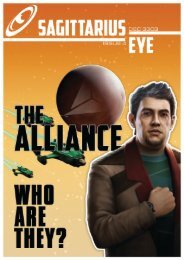Sageye issue 2
Create successful ePaper yourself
Turn your PDF publications into a flip-book with our unique Google optimized e-Paper software.
Are we at war?<br />
The repeated encounters I have had over the last two<br />
weeks with those inscrutable entities we refer to as<br />
‘Thargoids’ did not offer any clue to answering this<br />
question — the fatal question that looms over every<br />
human denizen of the Milky Way.<br />
To some — possibly the very same trigger-happy<br />
members of the Pilots Federation who have been taking<br />
upon themselves the task of blowing to pieces the<br />
‘alien invaders’ — the answer is obvious: yes, we are<br />
at war. But it seems to me that the minimal normative<br />
requirements necessary to declare a state of war<br />
are lacking, and that we are not even close to meeting<br />
them.<br />
The reason is simple: we don’t know anything<br />
about these entities. We don’t understand their<br />
technology, their motives, their form of social organization<br />
— if any — and, most crucially, we are<br />
not in the position to know if they share any human<br />
concept at all. Including the concept of ‘war’. Indeed,<br />
even though we heard rumours about ‘Oresrians’ and<br />
‘Klaxians’, we don’t know if those names are accurate.<br />
‘Thargoids’ is as arbitrary a designation as any other<br />
label we assign to that which eludes our cognitive<br />
grasp, to achieve the illusion of control.<br />
Without a more nuanced means for communicating<br />
with them than a battery of missiles, we will<br />
never shed any light on these unknowns. For what<br />
we know, the entities (spacecrafts?) we’ve met so far<br />
could be mere sentient machines, possessing no kind<br />
of sapience which would put them in the position of<br />
representing a warring opponent. Were our distant<br />
ancestors ‘at war’ with mammoths and sabertooth tigers?<br />
And yet, this analogy fails spectacularly to convey<br />
the genuinely alien character of the Thargoids.<br />
Prehistoric mammals were our close cousins compared<br />
to these inexplicable entities.<br />
I have been “hyperdicted” twice by them, and an<br />
eerie “dance” ensued: my AspX trying to elude the<br />
two flower-shaped crafts, maintaining a constant<br />
distance from my ship with a seemingly supernatural<br />
ease, while mutely staring at me. That was as<br />
unsettling an experience as I’ve ever had in my many<br />
decades of space-faring. No human being can ever<br />
experience a deeper feeling of powerlessness and<br />
loneliness as I did when floating in the cold darkness<br />
of space, being silently examined by faceless and<br />
indecipherable forms of life.<br />
Perhaps against my better judgment I have also<br />
jumped into several of those ‘Non-Human Signal<br />
Sources — as my on-board computer has labelled<br />
them — commonly found in the Pleiades cluster. But<br />
even there, I have never been attacked without provocation.<br />
Yes, my attempts at communicating occasionally<br />
took me to approach them too much — the<br />
Thargoid equivalent of ‘too close for comfort’ I suppose<br />
— and I have been fired upon, but that’s a flimsy<br />
basis to declare their uncompromising hostility. Has<br />
anyone actually witnessed them spontaneously opening<br />
fire on human vessels? Of course, this opens a far<br />
more sinister question: if they didn’t destroy those<br />
ships, who did? Rumors about two separate factions<br />
or groups of Thargoids abound: what if we are still to<br />
meet the bad guys?<br />
Someone will surely retort: “but they can be seen<br />
abducting people!” And that’s undeniable. But what<br />
do we know of the fate of those who are taken? Are<br />
they being rescued, or experimented upon? Reversing<br />
my argument, one could also hypothesize that<br />
we are nothing but animals for them: would you<br />
apologize to an ant colony if you were to pick up a<br />
few of its members to study them? I am not trying to<br />
convince you that the Thargoids are flower-shaped<br />
angels, coming to elevate us from our barbaric state<br />
of constant high-tech warfare. I am simply arguing<br />
that there’s very little that we know for sure, and that<br />
this ignorance could one day prove fatal to us all.<br />
For as long as there will be no communication<br />
with these entities we will never ascertain whether<br />
or not the conceptual schemes of our two species are<br />
so utterly incommensurable to make it impossible<br />
to share basic ideas such as ‘war’ or ‘peace’. And we<br />
will never find out if they are the aliens we should<br />
be worried about. For now, we’ve been trading with<br />
them only one concept — perhaps the Galaxy’s most<br />
basic one — death.<br />
As alien as they might be, I doubt that systematic<br />
extermination will represent a good precedent for a<br />
future cordial exchange of knowledge. Besides, we<br />
have already started to see how they are adapting to<br />
our newly-produced weapons — so much for AEGIS<br />
being a peaceful research institution!<br />
We have no idea of what — or who — might be<br />
coming next. Maybe, just maybe, the smoke and<br />
debris of our temporary victories are occluding from<br />
view a far more lethal threat.<br />
Wilfrid Sephiroth is a jaded spacer guided by the disenchanting purpose to uncover<br />
the false ‘awesome’ for the mundane it really is, and to reveal the interesting<br />
kernel of seemingly trivial events and happenings. He flies his Asp Explorer—<br />
the A.E. Van Vogt—around the bubble, always looking for the next Big Story.<br />
Usually, it’s the Big Story that finds him first.






